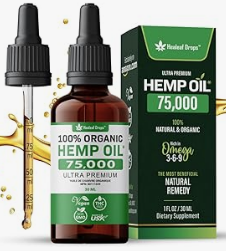
CBD oil or Hemp Oil has been getting a lot of buzz lately, and for good reason! It starts with cannabidiol, or CBD, which comes from cannabis plants. Unlike its famous cousin THC, the stuff that gets you high, CBD isn’t about that life. It’s all therapeutic vibes without the mind-altering effects.
Now, here’s where it gets scientific. Our bodies have this cool system called the endocannabinoid system, or ECS. It’s like a network of traffic signals guiding all sorts of bodily functions like mood, sleep, and even pain. CBD loves to jump in and lend a hand, adjusting these signals to help things run smoothly. That’s why some folks swear by its calming effects.
CBD’s versatility is one of its standout features.
People use it for a bunch of reasons:
It’s kind of like the Swiss army knife of wellness. Everyone’s experience is different, but stories about CBD’s benefits are popping up everywhere.
Different CBD products have their own vibes too. There are three main types: full-spectrum, broad-spectrum, and isolate. Full-spectrum combines CBD with other cannabinoids, including a smidge of THC, creating something called the ‘entourage effect’ where they all work together. Broad-spectrum is similar but skips the THC. Isolate is the purist’s choice, stripping it down to just CBD.
Choosing the right type and dosage can be a delicate dance, so it’s crucial to have some basic knowledge as you start your CBD journey. Think of it as laying the foundation before exploring deeper.
Finding the Right Dosage: Key Considerations
Starting your CBD journey can feel a bit like trying to find your favorite coffee order at a new café. It’s all about experimenting a little to see what works for you. For beginners, kicking things off with a low dose is usually the best way to go. Think of it as testing the waters before you dive in. Patience and a little trial and error are your best friends here.
When it comes to CBD, dosage isn’t a one-size-fits-all deal. Different factors come into play, like your weight, metabolism, and any health conditions you might have. Even your past experiences with CBD or other substances can shape how you react. It’s about tuning into your body’s unique rhythm and adjusting the volume dial until it hits just the right note.
Don’t hesitate to chat with healthcare professionals when you’re unsure about where to start. Doctors, especially those hip to the latest in cannabis research, can offer personalized guidance that aligns with your health needs. Their insights can be invaluable, particularly if you’re dealing with complex health issues or are on other medications.
Keep your senses alert for how your body responds. Maybe you’ll notice less stress, or perhaps a better night’s sleep starts showing up. If you’re not feeling the effects you’re after, it’s okay to tweak your dosage bit by bit. Just like finding the perfect playlist, it’s all about fine-tuning until it feels just right.
Administration Methods: Choosing How to Take CBD Oil
CBD oil’s got more than one trick up its sleeve when it comes to how you can take it. Sublingual application is a fan favorite—just drop it under your tongue and let it sit for a minute or so. It’s a quick way for CBD to mingle with your bloodstream.
- Pills and capsules are the way to go if you’re looking for a fuss-free method. Simply pop one with water, and you’re on your way. They’re clean, precise, and you don’t have to fret about measuring dosages.
- Topicals are all about targeted action. Creams and balms let you work CBD magic directly on sore spots. It’s like dialing in a soothing, localized balm just where you need it most.
- For those who don’t shy away from the smell and experience of hemp, vaping or smoking CBD flowers is an option. It delivers CBD straight to the lungs for rapid absorption, but it may not be for everyone, especially if you’re sensitive to smoke.
Every method has its groove. Sublingual and oral forms offer ease, while topicals cater to those who need specific relief, and inhalation delivers quick results. Balance convenience, preference, and the effects you’re after before settling on your go-to.
Integrating CBD into your daily life sounds like a tall order, but it’s doable with a little strategy. Consistency is key—try taking it at the same time every day. Keep your CBD in a visible spot, reminding you to check in with your wellness routine.
Safety should always ride shotgun on this journey. Make sure to source your CBD from reputable producers with transparent testing results. Proper storage is a must too, shielding it from direct sunlight and heat to keep it potent and effective.
Potential Benefits and Risks: Educated Guidance
CBD oil has certainly made a name for itself in wellness circles, but how about we peel back the layers and see what’s really going on? There’s a stack of research pointing towards its potential benefits—help with anxiety, pain reduction, better sleep, and a general sense of well-being are just some of the perks users report.
But, just like any wellness product, it’s not all sunshine and rainbows. Awareness of possible side effects is crucial. Some folks might experience dry mouth, drowsiness, or even some tummy trouble. That’s why taking it slow and monitoring your reaction is key.
Next up, let’s not ignore the legal landscape. While CBD is legal in many places, the rules can get a bit murky, depending on where you are. It’s always smart to check out the local regulations so you’re not caught off guard.
Staying clued in doesn’t stop once you’ve got your dosage sorted. Dive into CBD communities online, hit up forums, and keep an eye on new research findings. Arm yourself with information, and you’ll navigate your CBD journey like a pro.

Thank you for this detailed guide on CBD oil and dosage! It’s incredibly helpful for beginners like me who are just starting to explore CBD’s potential benefits. The explanations about the different types—full-spectrum, broad-spectrum, and isolate—are clear and really helped me understand how each one might suit different needs.
I do have a question about finding the right dosage: Is there a general timeframe to expect when you might start feeling effects, especially when beginning with a low dose? I know everyone’s body is different, but any guidance on what to expect timing-wise would be helpful. Also, is it best to stick with one administration method at first to gauge effectiveness, or can you combine methods, like using both sublingual drops and a topical? Thanks again for this beginner-friendly overview!
I would stick to one method to gauge its effectiveness. Everyone is different so when starting it is wise to take a smaller dose for a week and see how you feel, then increase if needed. I hope that helps answer your questions.